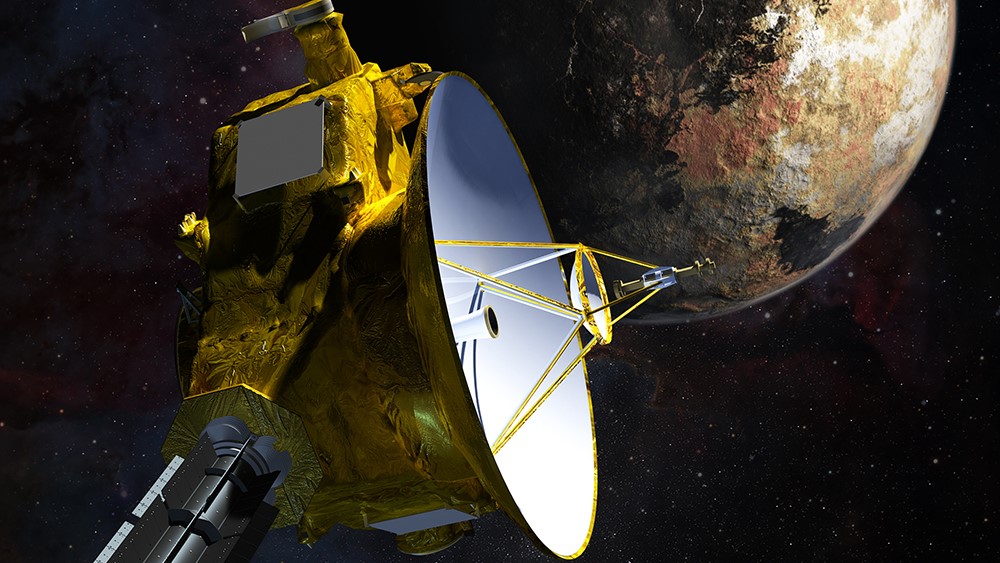Science
NASA’s New Horizons Proves Simple Interstellar Navigation Possible

NASA’s New Horizons spacecraft has successfully demonstrated a novel method for interstellar navigation using light from just two stars. An international research team measured the parallax of Proxima Centauri and Wolf 359 to determine the spacecraft’s location and trajectory. This technique, developed by researchers from various institutions, holds promise for future spacecraft exploring the outer regions of the solar system or embarking on interstellar missions.
New Horizons made headlines in 2015 when it flew past Pluto and has since ventured beyond the Kuiper Belt. On April 23, 2020, the spacecraft was positioned 47.1 astronomical units (AU)—approximately seven billion kilometres—from Earth. During this time, astronomers on Earth and New Horizons captured images of star fields containing Proxima Centauri, located just 4.2 light-years away, and Wolf 359, at 7.9 light-years. Utilizing these observations, the team aimed to replicate the distance determination through parallax measurements.
The concept of parallax relies on observing a star from two different vantage points. As New Horizons and Earth viewed Proxima and Wolf 359 from their respective positions, each star appeared slightly displaced against the backdrop of more distant stars. The research team recorded a parallax angle of 32.4 arcseconds for Proxima and 15.7 arcseconds for Wolf 359. By applying basic trigonometry, the scientists could triangulate New Horizons’ position.
Despite the theoretical feasibility, the researchers faced challenges in executing the observations, particularly due to the COVID-19 pandemic. As Edward Gomez from Cardiff University recalls, coordinating access to observatories was difficult during this time. He managed to capture images of Proxima Centauri using the Las Cumbres Observatory telescope network in Australia. Meanwhile, Wolf 359 was observed by the University of Louisville’s Manner Telescope at Mount Lemmon Observatory in Arizona.
At the same time, New Horizons utilized its Long Range Reconnaissance Imager (LORRI) to photograph both stars. The combined data from New Horizons and the Earth-based telescopes were then analyzed using a three-dimensional model of the stellar neighbourhood, constructed from data provided by the European Space Agency’s Gaia mission.
The results served primarily as a proof of concept rather than an exact determination of the spacecraft’s position. The team acknowledged that their measurements lacked high precision due to a limited number of observations. Gomez noted, “The reason why we call it an educational measurement is because we don’t have a high degree of, first, precision, and secondly, reproducibility.”
The positioning of New Horizons was calculated within 0.27 AU, while its heading was determined to an accuracy of 0.4 degrees relative to the precise value derived from NASA’s Deep Space Network signals. Gomez emphasized the significance of the method, stating, “The good thing about this method is just having two close stars as our reference stars. The handed-down wisdom normally is that you need loads and loads [of stars], but actually you just need two and that’s enough to triangulate your position.”
While more accurate navigation methods exist, such as pulsar measurements, these require complex instrumentation. Pulsar navigation has been demonstrated on the International Space Station, but this marks the first instance of interstellar navigation being successfully demonstrated for a spacecraft so far from Earth.
As of now, New Horizons continues its journey beyond the solar system, currently located 61 AU from Earth. When asked about the possibility of repeating the parallax measurements under better circumstances, Gomez expressed optimism. “I hope so. Now that we’ve written a paper in The Astronomical Journal that’s getting some interest, hopefully we can reproduce it, but nothing has been planned so far.”
Reflecting on the experience, Gomez noted the personal significance of the project. “When I was doing [high school] mathematics more years ago than I care to remember, I was a massive Star Trek fan and I did a three-dimensional interstellar navigation system as my mathematics project!” Now, he finds himself part of a team employing the stars to guide humanity’s first interstellar emissary.
-

 Health3 months ago
Health3 months agoNeurologist Warns Excessive Use of Supplements Can Harm Brain
-

 Health3 months ago
Health3 months agoFiona Phillips’ Husband Shares Heartfelt Update on Her Alzheimer’s Journey
-

 Science2 months ago
Science2 months agoBrian Cox Addresses Claims of Alien Probe in 3I/ATLAS Discovery
-

 Science2 months ago
Science2 months agoNASA Investigates Unusual Comet 3I/ATLAS; New Findings Emerge
-

 Science1 month ago
Science1 month agoScientists Examine 3I/ATLAS: Alien Artifact or Cosmic Oddity?
-

 Entertainment5 months ago
Entertainment5 months agoKerry Katona Discusses Future Baby Plans and Brian McFadden’s Wedding
-

 Science1 month ago
Science1 month agoNASA Investigates Speedy Object 3I/ATLAS, Sparking Speculation
-

 Entertainment4 months ago
Entertainment4 months agoEmmerdale Faces Tension as Dylan and April’s Lives Hang in the Balance
-

 World3 months ago
World3 months agoCole Palmer’s Cryptic Message to Kobbie Mainoo Following Loan Talks
-

 Science1 month ago
Science1 month agoNASA Scientists Explore Origins of 3I/ATLAS, a Fast-Moving Visitor
-

 Entertainment2 months ago
Entertainment2 months agoLewis Cope Addresses Accusations of Dance Training Advantage
-

 Entertainment3 months ago
Entertainment3 months agoMajor Cast Changes at Coronation Street: Exits and Returns in 2025









